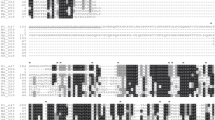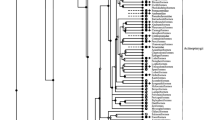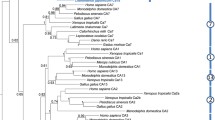Abstract
Carbonic anhydrases are conserved in vertebrates and invertebrates, and a noncatalytic carbonic anhydrase-related protein VIII (CARP VIII) has been found in deuterostomes and the phylum Placozoa. I isolated a cDNA encoding a noncatalytic CARP from the mantle of the pearl oyster Pinctada fucata. The polypeptide (CARP-1) predicted from the nucleotide sequence shares 44–60% identity with known CARP VIII sequences, and its phylogenetic analysis showed that P. fucata formed a single group with deuterostome invertebrates. However, since CARP VIII sequences are not identified in protostomes, these results suggest that CARP-1 may have originated in molluscs independently from deuterostome CARP VIII sequences.




Similar content being viewed by others
References
Barnea G, Silvennoinen O, Shaanan B, Honegger AM, Canoll PD, D’Eustachio P, Morse B, Levy JB, Laforgia S, Huebner K, Musacchio JM, Sap J, Schlessinger J (1993) Identification of a carbonic anhydrase-like domain in the extracellular region of RPTP gamma defines a new subfamily of receptor tyrosine phosphatases. Mol Cell Biol 13:1497–1506
Chapman JA, Kirkness EF, Simakov O, Hampson SE, Mitros T, Weinmaier T, Rattei T, Balasubramanian PG, Borman J, Busam D, Disbennett K, Pfannkoch C, Sumin N, Sutton GG, Viswanathan LD, Walenz B, Goodstein DM, Hellsten U, Kawashima T, Prochnik SE, Putnam NH, Shu S, Blumberg B, Dana CE, Gee L, Kibler DF, Law L, Lindgens D, Martinez DE, Peng J, Wigge PA, Bertulat B, Guder C, Nakamura Y, Ozbek S, Watanabe H, Khalturin K, Hemmrich G, Franke A, Augustin R, Fraune S, Hayakawa E, Hayakawa S, Hirose M, Hwang JS, Ikeo K, Nishimiya-Fujisawa C, Ogura A, Takahashi T, Steinmetz PR, Zhang X, Aufschnaiter R, Eder MK, Gorny AK, Salvenmoser W, Heimberg AM, Wheeler BM, Peterson KJ, Bottger A, Tischler P, Wolf A, Gojobori T, Remington KA, Strausberg RL, Venter JC, Technau U, Hobmayer B, Bosch TC, Holstein TW, Fujisawa T, Bode HR, David CN, Rokhsar DS, Steele RE (2010) The dynamic genome of Hydra. Nature 464:592–596
Collins AG (1998) Evaluating multiple alternative hypotheses for the origin of Bilateria: an analysis of 18S rRNA molecular evidence. Proc Natl Acad Sci USA 95:15458–15463
Elleby B, Sjoblom B, Tu C, Silverman DN, Lindskog S (2000) Enhancement of catalytic efficiency by the combination of site-specific mutations in a carbonic anhydrase-related protein. Eur J Biochem 267:5908–5915
Ender A, Schierwater B (2003) Placozoa are not derived cnidarians: evidence from molecular morphology. Mol Biol Evol 20:130–134
Hewett-Emmett D (2000) Evolution and distribution of the carbonic anhydrase gene families. In: Chegwidden WR, Carter ND, Edwards YH (eds) The carbonic anhydrases: new horizons. Birkhauser, Basel, pp 29–76
Hirota J, Ando H, Hamada K, Mikoshiba K (2003) Carbonic anhydrase-related protein is a novel binding protein for inositol 1,4,5-trisphosphate receptor type 1. Biochem J 372:435–441
Jiao Y, Yan J, Zhao Y, Donahue LR, Beamer WG, Li X, Roe BA, Ledoux MS, Gu W (2005) Carbonic anhydrase-related protein VIII deficiency is associated with a distinctive lifelong gait disorder in waddles mice. Genetics 171:1239–1246
Kato K (1990) Sequence of a novel carbonic anhydrase-related polypeptide and its exclusive presence in Purkinje cells. FEBS Lett 271:137–140
Kono M, Hayashi N, Samata T (2000) Molecular mechanism of the nacreous layer formation in Pinctada maxima. Biochem Biophys Res Commun 269:213–218
Levy JB, Canoll PD, Silvennoinen O, Barnea G, Morse B, Honegger AM, Huang JT, Cannizzaro LA, Park SH, Druck T, Huebner K, Sap J, Ehrlich M, Musacchio JM, Schlessinger J (1993) The cloning of a receptor-type protein tyrosine phosphatase expressed in the central nervous system. J Biol Chem 268:10573–10581
Lu SH, Takeuchi T, Fujita J, Ishida T, Akisawa Y, Nishimori I, Kohsaki T, Onishi S, Sonobe H, Ohtsuki Y (2004) Effect of carbonic anhydrase-related protein VIII expression on lung adenocarcinoma cell growth. Lung Cancer 44:273–280
Miyaji E, Nishimori I, Taniuchi K, Takeuchi T, Ohtsuki Y, Onishi S (2003) Overexpression of carbonic anhydrase-related protein VIII in human colorectal cancer. J Pathol 201:37–45
Miyamoto H, Miyashita T, Okushima M, Nakano S, Morita T, Matsushiro A (1996) A carbonic anhydrase from the nacreous layer in oyster pearls. Proc Natl Acad Sci USA 93:9657–9660
Miyamoto H, Yano M, Miyashita T (2003) Similarities in the structure of nacrein, the shell-matrix protein, in a bivalve and a gastropod. J Molluscan Stud 69:87–89
Miyamoto H, Miyoshi F, Kohno J (2005) The carbonic anhydrase domain protein nacrein is expressed in the epithelial cells of the mantle and acts as a negative regulator in calcification in the mollusc Pinctada fucata. Zool Sci 22:311–315
Putnam NH, Srivastava M, Hellsten U, Dirks B, Chapman J, Salamov A, Terry A, Shapiro H, Lindquist E, Kapitonov VV, Jurka J, Genikhovich G, Grigoriev IV, Lucas SM, Steele RE, Finnerty JR, Technau U, Martindale MQ, Rokhsar DS (2007) Sea anemone genome reveals ancestral eumetazoan gene repertoire and genomic organization. Science 317:86–94
Sjoblom B, Elleby B, Wallgren K, Jonsson BH, Lindskog S (1996) Two point mutations convert a catalytically inactive carbonic anhydrase-related protein (CARP) to an active enzyme. FEBS Lett 398:322–325
Skaggs LA, Bergenhem NC, Venta PJ, Tashian RE (1993) The deduced amino acid sequence of human carbonic anhydrase-related protein (CARP) is 98% identical to the mouse homologue. Gene 126:291–292
Supuran CT (2008) Carbonic anhydrases, an overview. Curr Pharm Des 14:603–614
Taniuchi K, Nishimori I, Takeuchi T, Fujikawa-Adachi K, Ohtsuki Y, Onishi S (2002a) Developmental expression of carbonic anhydrase-related proteins VIII, X, and XI in the human brain. Neuroscience 112:93–99
Taniuchi K, Nishimori I, Takeuchi T, Ohtsuki Y, Onishi S (2002b) cDNA cloning and developmental expression of murine carbonic anhydrase-related proteins VIII, X, and XI. Brain Res Mol Brain Res 109:207–215
Tashian RE (1989) The carbonic anhydrases: widening perspectives on their evolution, expression and function. BioEssays 10:186–192
Yan J, Jiao Y, Jiao F, Stuart J, Donahue LR, Beamer WG, Li X, Roe BA, LeDoux MS, Gu W (2007) Effects of carbonic anhydrase VIII deficiency on cerebellar gene expression profiles in the wdl mouse. Neurosci Lett 413:196–201
Acknowledgments
This study was supported by a grant from Wakayama Prefecture Collaboration of Regional Entities for the Advancement of Technological Excellence of JST (Japan Science and Technology Agency).
Author information
Authors and Affiliations
Corresponding author
Rights and permissions
About this article
Cite this article
Miyamoto, H. Sequence of the Pearl Oyster Carbonic Anhydrase-Related Protein and Its Evolutionary Implications. Biochem Genet 50, 269–276 (2012). https://doi.org/10.1007/s10528-011-9469-x
Received:
Accepted:
Published:
Issue Date:
DOI: https://doi.org/10.1007/s10528-011-9469-x




